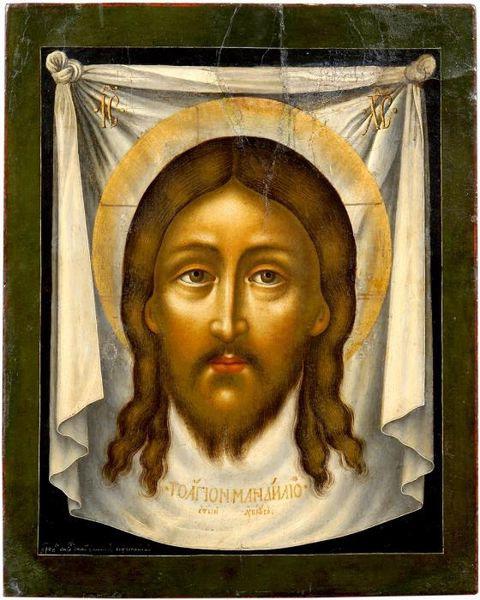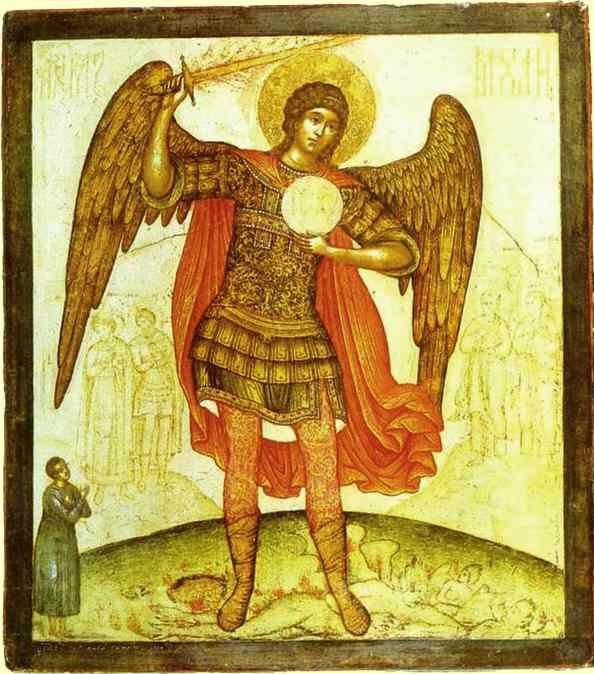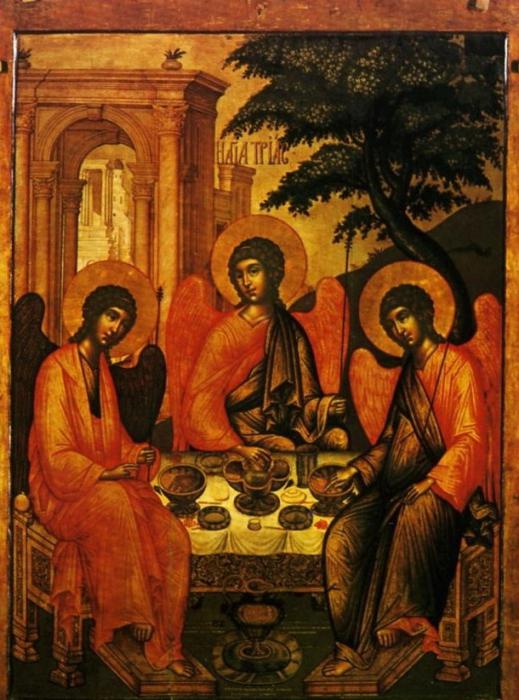The venerable, caressed courtyard of Tsar Alexei Mikhailovich, possessing multifaceted talent - in addition to icons, he painted murals, miniatures, and woodcuts - such was Simon Ushakov, whose biography sins only by the absence of an exact date and month of birth and the unknown origin. But this is already progress, since his great predecessors Andrei Rublev and Theophanes the Greek do not know either the date, month, or even year of birth, and the latter has the date of death indicated with the prefix “about”.
Not an anonymous author at all
A lot is known about Ushakov, even the fact that Simon is his nickname, and he was named after Pimen. This became known because the icon painter Simon Ushakov was the first to make his work copyright. And so, on one of the icons, completed in 1677, he indicates that Pimen Fedorov wrote it, nicknamed Simon Ushakov. Having two names was a tradition in those days - one “hidden” received at baptism was dedicated to God. It could not be pronounced in vain. Another, "call", everyday, was meant for life. Information about the artist can be obtained from the signatures on other icons - one of them is stored in the Georgian Church in Kitay-Gorod. Actually, most of his works are signed.
New trends
Ushakov Simon Fedorovich, the famous Moscow icon painter of the 17th century, is considered a bright representative of the last period of the art of Muscovite Russia, which began with the construction of the Kremlin, which became a symbol of a united country. A new stage in the history of Russian culture is characterized by new techniques and approaches to the depicted subject. The painting and architecture of ancient Russia absorbed the skill of representatives of various schools, including Italian. All of them worked on the construction and painting of the Kremlin chambers. New trends have made architecture, icon painting and other types of creativity more decorative, the colors have become brighter, the images more plastic.
Russian Renaissance
In general, this transition period from old to new art was bright and full of masterpieces of talented (icon painter Simon - its main representative) people. And therefore, in history, the second half of the 17th century is often compared with the Western Renaissance or the Baroque era. Indeed, all forms of art and construction experienced a boom. Architecture flourished - a very large number of temples were built.
Secrets of Origin
Simon Ushakov is a talented painter and graphic artist, apparently from an early age he studied the artist’s skills, since rarely before and after he was admitted to the Silver House to the official position of the denominator at such a young age - at 22 years old. The exact date of birth is not known, nor is the origin. There is only a year of birth - 1626, and the assumption that Simon Ushakov comes from the posad people, that is, he came from the medieval estate of formally free people. Although one of the icons signed by him (as noted above, he was the first to designate his works) contradicts this - the icon painter calls himself there “Moscow nobleman”. Most likely, he did not lie, and later received the title as a sign of special distinction on the part of those in power. Another researcher of Ushakov’s work, Boris Shevatov, writes that Simon was even a hereditary nobleman and that is why he had the opportunity to master his skills and then get a public position with a salary.
Variety of talent
At the place of the first service, his duties included the creation of sketches of various kinds: for gold, silver, enamel church utensils. The painting of banners was also part of his duties, as was the development of patterns and motifs for embroidery. The number of tasks necessary for the execution was large, but Simon Ushakov managed to paint images all the time, both for the church and for people, gradually becoming the most famous icon painter. By making skillful cards, painting church walls, beautiful notches on guns, this talented man became famous for all this and many others.
Fanatical hard work
Mastery, industriousness, amazing working capacity attracted the attention of his superiors, and in 1664 he was transferred to the Armory, where he was assigned the well-paid position of the “saluted isograph”. Talent is honed, fame is expanding, and now Simon Ushakov is at the head of all icon painters in Moscow. The biography of his later life suggests that he was not familiar with the poverty and non-recognition usually associated with many artists. The last of the brilliant icon painters of the pre-Petrine era died in Moscow in 1686, surrounded by fame, wealth and recognition.
Shadow biography moments
Although there were unpleasant moments - in 1665 the artist fell into disgrace. He was even exiled to the monastery, apparently to Ugreshsky. But the exact address is unknown, as well as the reason that caused the king’s irritation - either nudity in one of the paintings, or sympathetic statements addressed to the Old Believers. However, in 1666, the artist was again referred to as a royal servant.
First icons
The first known work of the master is considered the image of the Mother of God of Vladimir, dated 1652. He is remarkable only in that five years after him the first Savior, the miraculous of Simon Ushakov, saw the light of day. They argue about him, he may like it or not, but the image became known for violating the canons of writing. Realistic features appear in it, it is carefully and voluminously written out. Jesus has eyelashes, his eyes shine as if from a tear. And, despite this, the church accepted the icon. Of course, this was not a revolutionary word in icon painting, but it certainly became something new.
Software image

In total, several of these images were written - some experts believe that in the artist's work he became programmatic. Trying to get as close as possible to the ubrus, on which, having wet his face, Christ himself left his miraculous image, Ushakov constantly improves his icons - changes some features, adds or removes inscriptions. It is believed that the artist himself and the students of the workshop created under his supervision began to be the first to equal Western masters. They began to introduce human features into the faces of saints depicted by them, which was not in the old Russian icon painting. Representatives of Ushakov’s school, in his own words, tried to “write like a lively one,” that is, approaching reality in their work, for which they were harshly criticized by the Old Believers (Avvakum generally said that Ushakov, painting Christ, was blaspheming). The miraculous Simon Ushakov, dated 1670, was saved for the Trinity Cathedral of the Alexander Sloboda. Now it is stored in the Armory.
Images become more humane
The faces on the icons of Ushakov were very different from the images of the Old Believers, whose name is the explanation for this. Old ceremonies, hard-kept for centuries, dictated the way of writing icons, very far from the surrounding reality. Darkened from time to time, they were strikingly different from light ones, since “God is light”, more colorful and calm images of saints from Ushakov’s icons. In his work, for the first time, old ancient Russian art and new realistic trends were combined.
In his works for the first time appear elements of the "frigid" or Western art. He borrows from them the perspective, and sometimes the plot - "The Seven Deadly Sins." There are dozens of Western paintings and prints on this subject.
Art credo

Concluding a series of great Russian icon painters - Theophanes the Greek, Andrei Rublev, Dionysius - Simon Ushakov becomes a bridge to the next stage in the development of Russian painting. The enlightener displayed his views on art, on the responsibility of authors for his works, on the reality of the depicted object in his book, “The Word to the Philosophical Icon Writing”, which was published in 1666, written, possibly, in exile. The views expressed in it by the author are so progressive that some critics expressed the idea that in his pictorial work he was not so bold. In the book, he praises the "principle of the mirror", which speaks of the desire for precision images. In this regard, the artist developed a new method of writing - small, barely distinguishable strokes that make the color transition invisible, they were called "swim" and were layered. This made it possible to draw an oval of the face, the color of which was close to real, to make the chin and neck rounded, to emphasize the swelling of the lips, to carefully draw out the eyes. Ushakov honed all these tricks on his favorite images - the Savior and the Virgin.
Go to portrait
Thanks to this, he was called “Russian Raphael” during his lifetime. And not in vain. Because the first portrait of Simon Ushakov, or rather his brush, or parsun (a word came from the Latin term persona - personality) is also a new word in art. He painted a tombstone portrait of Skopin-Shuisky, a number of other parsuns of the Moscow nobility. His most famous icon, which is considered the greatest work of the 17th century, the artistic and political program of the era - “The Tree of the State of Moscow”, also known as “Praise to Our Lady of Vladimir” or simply ““ Our Lady of Vladimir ”, can be attributed to portrait work. and other names.
The main work of the master
On this unusual icon, in addition to the Kremlin walls, painted as truthfully as possible and located below the picture, the Assumption Cathedral is depicted. This main shrine of the Russian state is also depicted with photographic accuracy. At its foot two people plant a tree of the “Russian state - these are the collectors of Russian lands Ivan Kalita and the Moscow Metropolitan Peter, known for transferring the symbol of spiritual authority, the Metropolitan’s pulpit to Moscow from Vladimir, thus designating the vertical of power.
Artwork - Historical Epic
On the branches of the tree, Simon Ushakov arranged medallions containing portraits of people - tsars (Fedor Ivanovich, Mikhail Fedorovich, Tsarevich Dmitry) and saints with prayer scrolls in their hands, who did everything to strengthen the Moscow state and its capital Moscow - the political and spiritual center. On the right are the patriarchs Job and Filaret. Metropolitans Jonah, Alexius, Cyprian, Philip and Photius. Left: Sergius and Nikon of Radonezh and other pillars of Orthodoxy. The portraits of Alexei Mikhailovich, which he ordered to Ushakov in considerable quantities, were not preserved. And all the more interesting and significant is the Parsun on the icon, since the author tried to give it a complete resemblance to the original. The tsar himself, his wife and two tsarevichs, Alexei and Fedor, are depicted by a group standing on the territory of the Kremlin. In the clouds, angels take from the hands of the Savior the attributes of power for Alexei Mikhailovich. All this symbolizes the process of weddings on the kingdom of the earthly ruler of the heavenly king. In the center of the icon is the face of the Mother of God of God with the baby Jesus in her arms. The canvas is signed, like the rest of the work of Simon Ushakov.
Other works of genius
His works include frescoes on the walls of the Faceted and Tsar’s Chambers of the Kremlin, the walls of the Arkhangelsk and Assumption Cathedrals. Considering the versatility and diversity of creativity (coins were minted according to Ushakov's sketches), a lot of works remained.
Separate words deserve the icons of Simon Ushakov. In addition to the aforementioned Holy Savior in various modifications and several icons of Our Lady of Vladimir, the faces of Christ Emanuel, Our Lady of Kazan, the Annunciation, and the Calvary Cross are known .
Transitional stage to painting

To date, 50 icons are known, which were signed by Simon Ushakov. “Trinity” deserves a separate description. It was performed in adulthood - in 1671. The date is indicated both from Adam and from the Nativity of Christ. Extended signatures are often made on the front side of the canvas. The icon has been stored since 1925 in the Russian Museum, where it came from the Gatchina Palace. The composition of the icon was borrowed from Andrei Rublev, whose work, as is commonly believed, is inferior in spirituality and philosophical sound. This is due to the oversaturation of the canvas with carefully written household items. With these secular details, some icons more closely resemble painting. She always interested in Simon Ushakov. He was engaged in renovation, that is, restoration of paintings. Actually, the “Trinity” is a step in the transition from icon painting to fine art in its purest form. He was well acquainted with the masters of Western schools and sometimes borrowed the
background for his icons from major artists such as Veronese. Therefore, Ushakov is not only a great icon painter, but also a talented artist and graphic artist.
Pupils and associates
His many talents include the gift of teaching. Simon Ushakov even worked on a textbook for his students, the book was called "The Alphabet of Arts." After his death, which occurred on June 25, 1686, there remained an excellent art school of followers, among whose students there were such large painters and icon painters as Tikhon Filatiev, Kirill Ulanov, George Zinoviev, Ivan Maximov and Mikhail Milyutin.